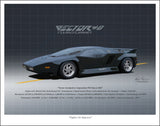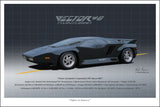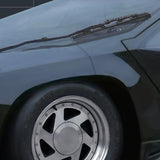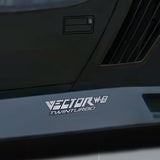The Vector Aeromotive Corporation W8 was the brainchild of Gerald Wiegert and was produced between 1989 and 1993. It was developed from the earlier W2 prototype which was first shown to the public in 1976. Refinements by Vector's head of engineering David Kostka and years of trying to secure funding eventually resulted in the W8.
The design philosophy was to incorporate aviation technology into an advanced automobile. Also, the car was designed to last the lifetime of the owner. The car incorporated the newest and most advanced aerospace materials. The chassis was of aluminum monocoque construction with an aluminum honeycomb structure floor pan epoxy bonded and riveted with 5,000 aircraft specification rivets. The W8 body utilized lightweight carbon fiber and Kevlar. This was very advanced for its time. Prior to production, the W8 successfully passed DOT crash tests using a single chassis for all the tests including front and rear collisions and roof crush tests. It is the only car ever to do so.
The W8 was powered by Rodeck aluminum resleevable 365 cu in racing engine featuring two intercooled Garrett turbochargers. It produced an advertised power output of 625 HP at 5,700 RPM and 649 lbft of torque at 4,900 RPM on 8 PSI of boost pressure. The boost pressure was adjustable by the driver up to a maximum of 14 PSA. During factory dyno testing, a maximum engine output of 1,200 BHP was recorded at 14 PSI of boost pressure. All that power was transmitted to the wheels via a heavily modified, General Motors Turbo Hydromatic 425 automatic transmission. Vector projected the W8 could accelerate from 0-60 MPH in 3.9 seconds and could reach a projected top speed of 242 MPH. (Testing by Road & Track magazine produced a 0-60 time of 4.2 second.) The W8 generated a skidpad acceleration of 0.97g when cornering. This was the highest in its class at the time.
The main dashboard display was a LCD screen the same as that used on fighter jets. It had four display modes with information about the car's status. The dashboard featured aircraft style controls for adjusting the car's various functions and lighting. The interior was upholstered in leather and suede as well as wool carpeting and floor mats. It was equipped with an extremely well-functioning air-conditioning system with eyeball vent openings as used on aircraft. There was an optional heads-up-display (HUD) available although none of the cars produced were equipped with this option.
A total of nineteen W8s were produced (seventeen customer and two pre-production cars) before Vector went into receivership in 1993. All the cars survive and are highly sought by collectors.
The design philosophy was to incorporate aviation technology into an advanced automobile. Also, the car was designed to last the lifetime of the owner. The car incorporated the newest and most advanced aerospace materials. The chassis was of aluminum monocoque construction with an aluminum honeycomb structure floor pan epoxy bonded and riveted with 5,000 aircraft specification rivets. The W8 body utilized lightweight carbon fiber and Kevlar. This was very advanced for its time. Prior to production, the W8 successfully passed DOT crash tests using a single chassis for all the tests including front and rear collisions and roof crush tests. It is the only car ever to do so.
The W8 was powered by Rodeck aluminum resleevable 365 cu in racing engine featuring two intercooled Garrett turbochargers. It produced an advertised power output of 625 HP at 5,700 RPM and 649 lbft of torque at 4,900 RPM on 8 PSI of boost pressure. The boost pressure was adjustable by the driver up to a maximum of 14 PSA. During factory dyno testing, a maximum engine output of 1,200 BHP was recorded at 14 PSI of boost pressure. All that power was transmitted to the wheels via a heavily modified, General Motors Turbo Hydromatic 425 automatic transmission. Vector projected the W8 could accelerate from 0-60 MPH in 3.9 seconds and could reach a projected top speed of 242 MPH. (Testing by Road & Track magazine produced a 0-60 time of 4.2 second.) The W8 generated a skidpad acceleration of 0.97g when cornering. This was the highest in its class at the time.
The main dashboard display was a LCD screen the same as that used on fighter jets. It had four display modes with information about the car's status. The dashboard featured aircraft style controls for adjusting the car's various functions and lighting. The interior was upholstered in leather and suede as well as wool carpeting and floor mats. It was equipped with an extremely well-functioning air-conditioning system with eyeball vent openings as used on aircraft. There was an optional heads-up-display (HUD) available although none of the cars produced were equipped with this option.
A total of nineteen W8s were produced (seventeen customer and two pre-production cars) before Vector went into receivership in 1993. All the cars survive and are highly sought by collectors.








